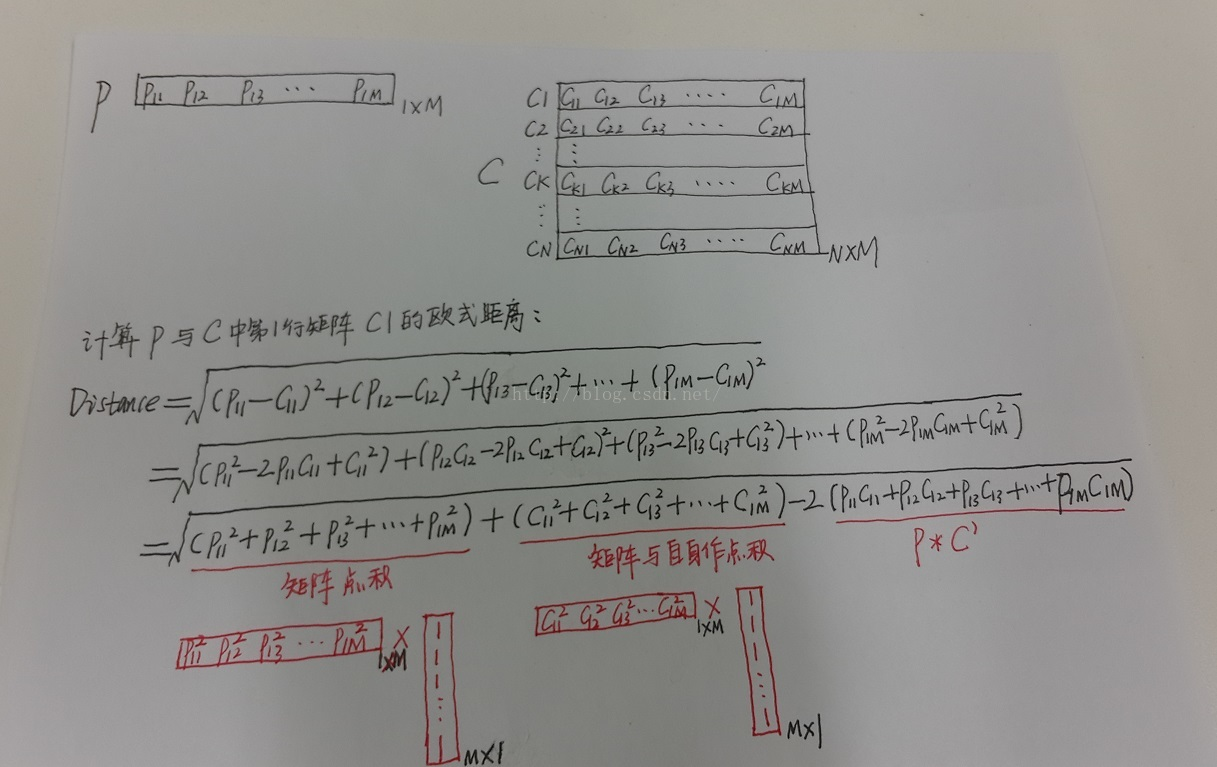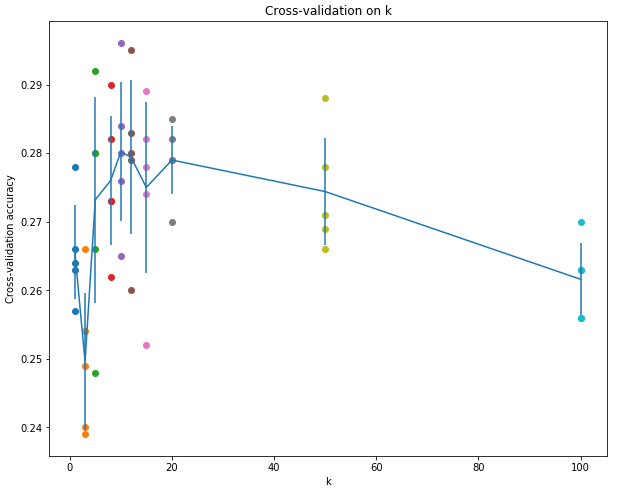CS231N assignment1
# Visualize some examples from the dataset.
# We show a few examples of training images from each class.
classes = ['plane', 'car', 'bird', 'cat', 'deer', 'dog', 'frog', 'horse', 'ship', 'truck'] #类别列表
num_classes = len(classes) #类别数目
samples_per_class = 7 # 每个类别采样个数
for y, cls in enumerate(classes): # 对列表的元素位置和元素进行循环,y表示元素位置(0,num_class),cls元素本身'plane'等
idxs = np.flatnonzero(y_train == y) #找出标签中y类的位置
idxs = np.random.choice(idxs, samples_per_class, replace=False) #从中选出我们所需的7个样本
for i, idx in enumerate(idxs): #对所选的样本的位置和样本所对应的图片在训练集中的位置进行循环
plt_idx = i * num_classes + y + 1 # 在子图中所占位置的计算
plt.subplot(samples_per_class, num_classes, plt_idx) # 说明要画的子图的编号
plt.imshow(X_train[idx].astype('uint8')) # 画图
plt.axis('off')
if i == 0:
plt.title(cls) # 写上标题,也就是类别名
plt.show() # 显示

用矩阵运算取代两次循环运算,大大减少运算时间。
核心的公式:https://blog.csdn.net/zhyh1435589631/article/details/54236643
https://blog.csdn.net/geekmanong/article/details/51524402

我自己的经验总结:先看最终目标矩阵的大小,可以确定前面位置。

交叉验证这里:
在进行分类前,一定要通过reshape函数,来确定数据输入的形状是不是符合要求。
num_folds = 5
k_choices = [1, 3, 5, 8, 10, 12, 15, 20, 50, 100] X_train_folds = []
y_train_folds = []
################################################################################
# TODO: #
# Split up the training data into folds. After splitting, X_train_folds and #
# y_train_folds should each be lists of length num_folds, where #
# y_train_folds[i] is the label vector for the points in X_train_folds[i]. #
# Hint: Look up the numpy array_split function. #
################################################################################
X_train_folds=np.array_split(X_train,num_folds)
y_train_folds=np.array_split(y_train,num_folds) ################################################################################
# END OF YOUR CODE #
################################################################################ # A dictionary holding the accuracies for different values of k that we find
# when running cross-validation. After running cross-validation,
# k_to_accuracies[k] should be a list of length num_folds giving the different
# accuracy values that we found when using that value of k.
k_to_accuracies = {} ################################################################################
# TODO: #
# Perform k-fold cross validation to find the best value of k. For each #
# possible value of k, run the k-nearest-neighbor algorithm num_folds times, #
# where in each case you use all but one of the folds as training data and the #
# last fold as a validation set. Store the accuracies for all fold and all #
# values of k in the k_to_accuracies dictionary. #
################################################################################
num_test = X_train_folds[0].shape[0]
for j in range(len(k_choices)):
k = k_choices[j]
for i in range(1,num_folds+1):
X_train_temp = np.concatenate((X_train_folds[num_folds-i],X_train_folds[num_folds-i-1],X_train_folds[num_folds-i-2],X_train_folds[num_folds-i-3]),axis = 0)
y_train_temp = np.concatenate((y_train_folds[num_folds-i],y_train_folds[num_folds-i-1],y_train_folds[num_folds-i-2],y_train_folds[num_folds-i-3]))
X_test_temp = X_train_folds[num_folds-i-4]
y_test_temp = y_train_folds[num_folds-i-4]
classifier.train(X_train_temp, y_train_temp)
y_test_pred = classifier.predict(X_test_temp, k=k)
num_correct = np.sum(y_test_pred == y_test_temp)
accuracy = float(num_correct) / num_test
k_to_accuracies.setdefault(k,[]).append(accuracy) ################################################################################
# END OF YOUR CODE #
################################################################################ # Print out the computed accuracies
for k in sorted(k_to_accuracies):
for accuracy in k_to_accuracies[k]:
print('k = %d, accuracy = %f' % (k, accuracy))
将所有数据分为train/val/test三组,使用train训练,用val调整超参数,在最后的最后,才可以使用test,并且test只允许使用这一次,并将这一次的结果作为最终结果上报。否则得到的classifier会overfitting,或者结果不准确,有cheat的嫌疑。
Evaluate on the test set only a single time, at the very end.
所谓5-fold cross validation就是将所有的train data均匀分成5份,每次取4份做train,另外一份做val,重复五次,将五次结果平均。这样做的话每个数据都做了四次train,一次val。这样做的缺点是太expensive,NN中通常不用。注意,在这个过程中,test是不参与其中的。一定先将test set拿出来放到一边,不到最后交结果的时候不要碰它。



1,2显然不正确;因为kNN是非线性分类器,所以边界也是非线性的;training set越大,在predict时需要计算test example与所有training的距离,所以在相同算力条件下,taining set越大,predict一个test sample所需时间越多,时间复杂度为O(N)。
CS231N assignment1的更多相关文章
- cs231n assignment1 KNN
title: cs231n assignment1 KNN tags: - KNN - cs231n categories: - 机器学习 date: 2019年9月16日 17:03:13 利用KN ...
- 笔记:CS231n+assignment1(作业一)
CS231n的课后作业非常的好,这里记录一下自己对作业一些笔记. 一.第一个是KNN的代码,这里的trick是计算距离的三种方法,核心的话还是python和machine learning中非常实用的 ...
- 【cs231n笔记】assignment1之KNN
k-Nearest Neighbor (kNN) 练习 这篇博文是对cs231n课程assignment1的第一个问题KNN算法的完成,参考了一些网上的博客,不具有什么创造性,以个人学习笔记为目的发布 ...
- 【cs231n作业笔记】二:SVM分类器
可以参考:cs231n assignment1 SVM 完整代码 231n作业 多类 SVM 的损失函数及其梯度计算(最好)https://blog.csdn.net/NODIECANFLY/ar ...
- cs231n线性分类器作业 svm代码 softmax
CS231n之线性分类器 斯坦福CS231n项目实战(二):线性支持向量机SVM CS231n 2016 通关 第三章-SVM与Softmax cs231n:assignment1——Q3: Impl ...
- 【cs231n作业笔记】一:KNN分类器
安装anaconda,下载assignment作业代码 作业代码数据集等2018版基于python3.6 下载提取码4put 本课程内容参考: cs231n官方笔记地址 贺完结!CS231n官方笔记授 ...
- cs231n笔记:线性分类器
cs231n线性分类器学习笔记,非完全翻译,根据自己的学习情况总结出的内容: 线性分类 本节介绍线性分类器,该方法可以自然延伸到神经网络和卷积神经网络中,这类方法主要有两部分组成,一个是评分函数(sc ...
- CS231n 2017 学习笔记01——KNN(K-Nearest Neighbors)
本博客内容来自 Stanford University CS231N 2017 Lecture 2 - Image Classification 课程官网:http://cs231n.stanford ...
- cs231n --- 3 : Convolutional Neural Networks (CNNs / ConvNets)
CNN介绍 与之前的神经网络不同之处在于,CNN明确指定了输入就是图像,这允许我们将某些特征编码到CNN的结构中去,不仅易于实现,还能极大减少网络的参数. 一. 结构概述 与一般的神经网络不同,卷积神 ...
随机推荐
- 【学习笔记】--- 老男孩学Python,day16-17 初识面向对象,类名称空间,查询顺序,组合
面向过程 VS 面向对象 面向过程的程序设计的核心是过程(流水线式思维),过程即解决问题的步骤,面向过程的设计就好比精心设计好一条流水线,考虑周全什么时候处理什么东西. 优点是:极大的降低了写程序的复 ...
- 移除button点击时的黑边
input[type=submit], input[type=reset], input[type=button]{ outline:none; filter: chroma(color=#00000 ...
- 移动端h5实现拍照上传图片并预览&webuploader
.移动端实现图片上传并预览,用到h5的input的file属性及filereader对象:经测除了android上不支持多图片上传,其他基本ok实用: 一:先说一下单张图片上传(先上代码): html ...
- opencv3.2.0形态学滤波之腐蚀
/* 腐蚀(erode)含义: 腐蚀和膨胀是相反的一对操作,所以腐蚀就是求局部最小值的操作,腐蚀操作使原图中 国的高亮部分被腐蚀,效果图比原图有更小的高亮的区域. 腐蚀函数原型API及参数同膨胀相同 ...
- 增加图例 Legend和删除图例
private void button1_Click(object sender, System.EventArgs e) { //Get the GraphicsContainer IGraphic ...
- 使用jvisualvm的jstatd方式远程监控Java程序
使用Java自带的jvisualvm调试Java程序,可以查看CPU.内存.类及线程等信息,还可以进行Dump,无疑是一个利器 由于客户端是Windows.服务端是Linux,并且是最小安装的Linu ...
- Android Toast:是一个类,主要管理消息的提示
Toast:是一个类,主要管理消息的提示.makeText(),是Toast的一个方法,用来显示信息,分别有三个参数.第一个参数:this,是上下文参数,指当前页面显示第二个参数:“string st ...
- 为何说 JavaScript 开发很疯狂
[编者按]本文作者为 Sean Fioritto,主要阐述了 JavaScript 开发为何让人有些无从下手的根本原因.文章系国内 ITOM 管理平台 OneAPM 编译呈现. 网络开发乐趣多多!Ja ...
- select2加载远程数据示例
核心js $("#query_pack_code").select2({ language: "zh-CN", allowClear: true, width: ...
- 《鸟哥的Linux私房菜》Chapter11 20180726~20180806
目录 1.认识Bash这个shell 1.1.硬件.核心与shell 1.2.系统的合法shell和/etc/shells功能 1.3.Bash shell的功能 1.3.1.命令修编功能 1.3.2 ...
